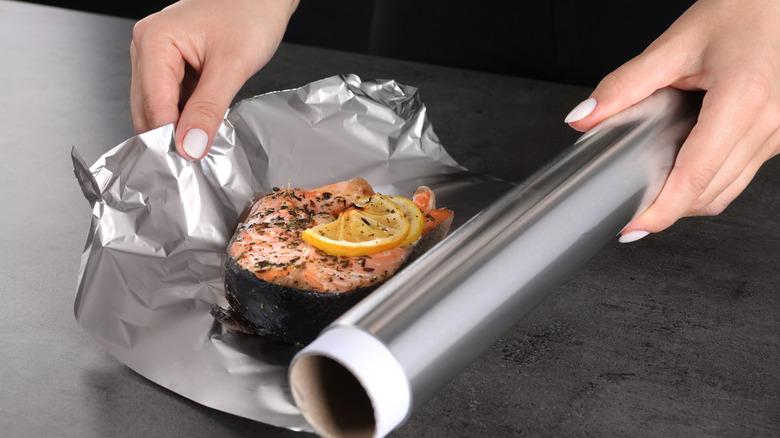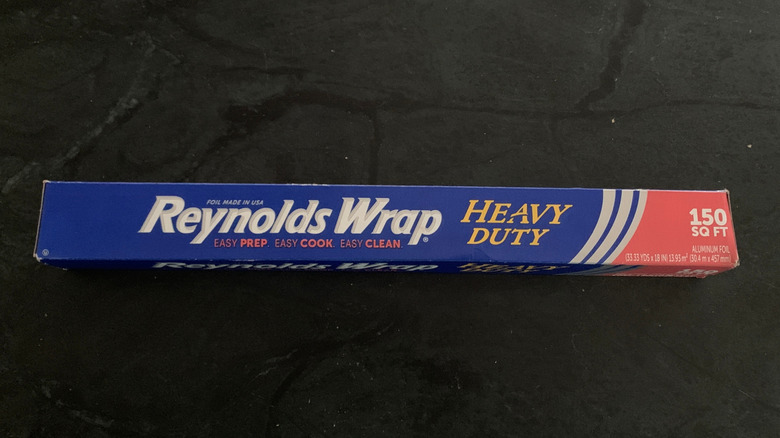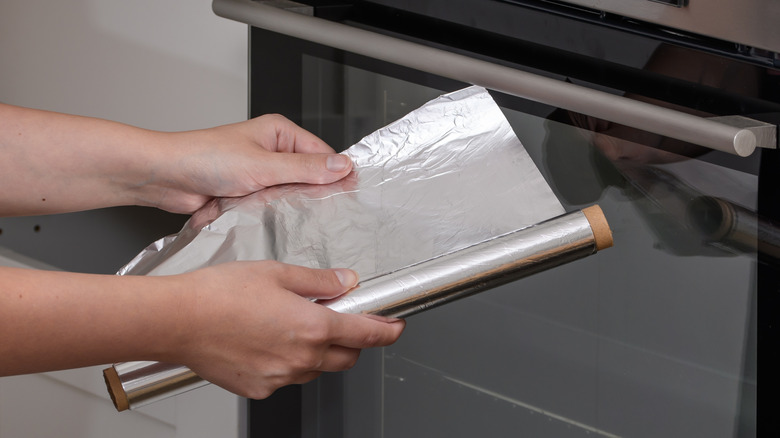Heavy-Duty Vs Regular Aluminum Foil: What's The Difference?
Aluminum foil can be a heavy-hitter in the kitchen, serving both as a cooking tool and a way to store leftovers after the meal is over. The product was patented in 1910, over 100 years ago, and has been used to wrap food since the very beginning. Toblerone, a candy bar that's been around longer than you think, predating aluminum foil, started to use it only a year later. Over the years, though, the product has changed, becoming lighter and therefore cheaper to produce. Aluminum foil began to take various forms, as well, leading to the creation of heavy-duty aluminum foil.
Many brands, such as Reynolds Wrap, Great Value, and Kroger, sell heavy-duty aluminum foil alongside the standard product, usually at a bit of a markup. For instance, Kroger's regular aluminum foil costs about eight cents a square foot in the Cincinnati area, while the heavy-duty foil is closer to ten cents a square foot. If you've ever passed on that markup because you didn't know the difference, you're not alone. Luckily, we're here to help by examining the differences between standard and heavy-duty aluminum foil. For this comparison, we'll be specifically looking at Reynolds Wrap, since, per Statista, it is the most commonly used brand. Note that different brands might define their heavy-duty wrap slightly differently.
What is heavy-duty aluminum foil like?
As Reynolds Wrap says on its site, "Heavy Duty Aluminum Foil is perfect for when you need extra strength and durability while cooking." The foil is much thicker and less likely to tear, making it the preferred method for wrapping things like thick cuts of meat or for wrapping anything with a sharper edge or corner. The image included on the site shows an entire chicken in a pan being wrapped in heavy-duty foil. This showcases that it's perfect for situations where you need to wrap something larger or generally difficult to cover.
In addition, the foil is grill-safe, oven-safe, and recyclable in certain areas. Along with being more expensive, heavy-duty foil also tends to come in larger quantities, with the smallest size of heavy-duty Reynolds Wrap available being 30 square feet compared to the 15 square foot size of a small box of standard Reynolds Wrap. Like all aluminum foil, it has a shiny and a dull side, but there's no functional difference between the two textures when it comes to cooking.
What is standard aluminum foil like? (And which to get)
In comparison to heavy-duty aluminum foil, standard aluminum foil is much thinner, which makes it more prone to tearing. Reynolds Wrap says that standard aluminum foil should not be used to cover pans larger than 13 inches by 9 inches, and while it's both grill and freezer-safe, it isn't noted as being oven-safe like the heavy-duty variety is, making it unsuitable for things like oven-roasted chicken or potatoes. However, so long as you avoid common mistakes, it should be suitable for everyday uses like grilling smaller items or wrapping leftovers.
If you're cooking something in the oven, wrapping large pans, or grilling thick chunks of meat, consider grabbing heavy-duty aluminum foil rather than the standard variety. However, if you're simply lining a pan to avoid messy cleanup or trying to save your burrito for tomorrow, standard aluminum foil should do the trick without tearing. Many home cooks actually keep both to use for different purposes so as not to waste money using higher quality foil on simple uses where it isn't necessary. The best one to use comes down to budget and purpose; if you don't mind spending a few extra bucks, you can simply use heavy-duty foil for everything. Otherwise, consider keeping some heavy-duty foil on hand only for more intensive purposes.


